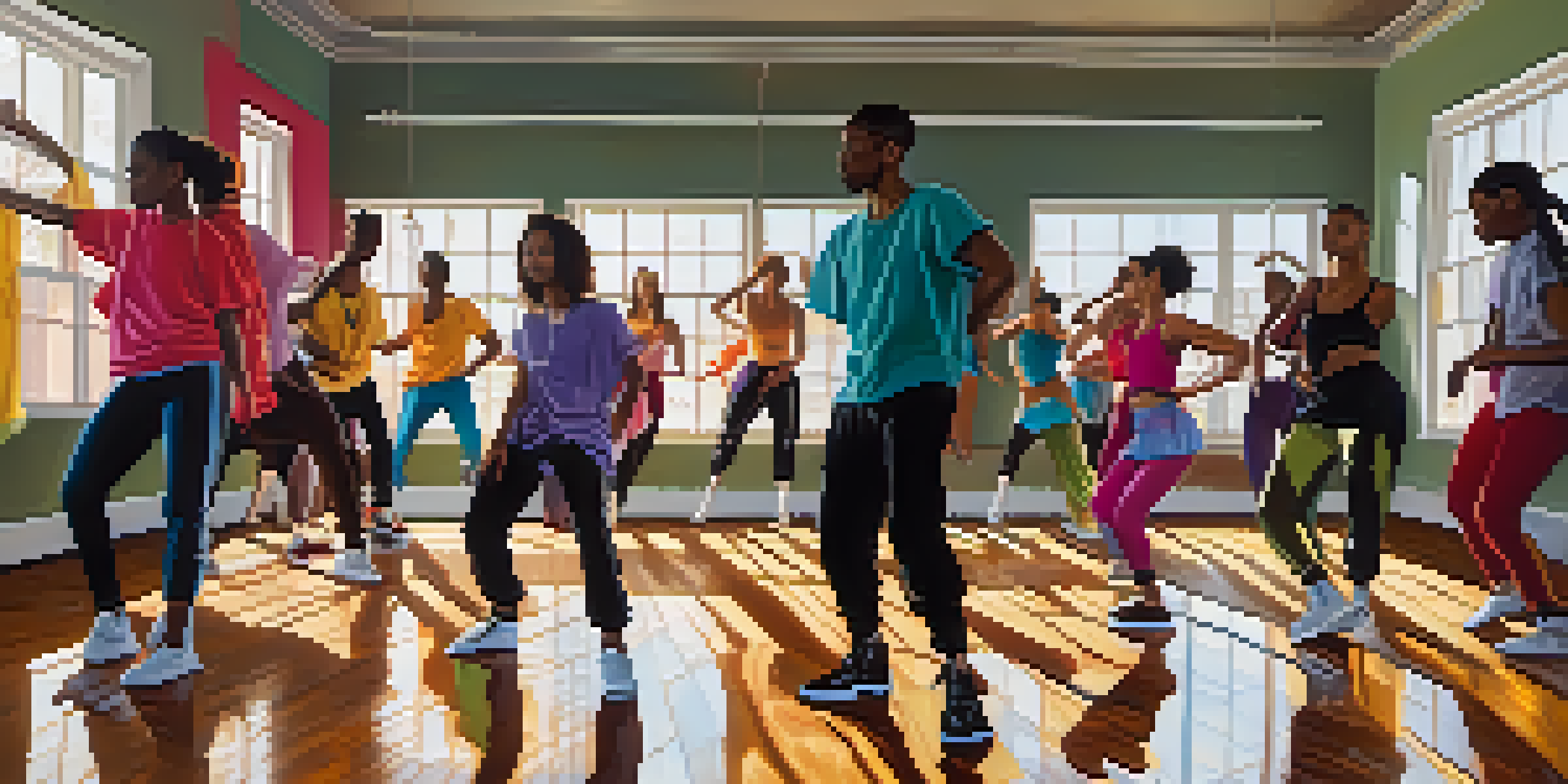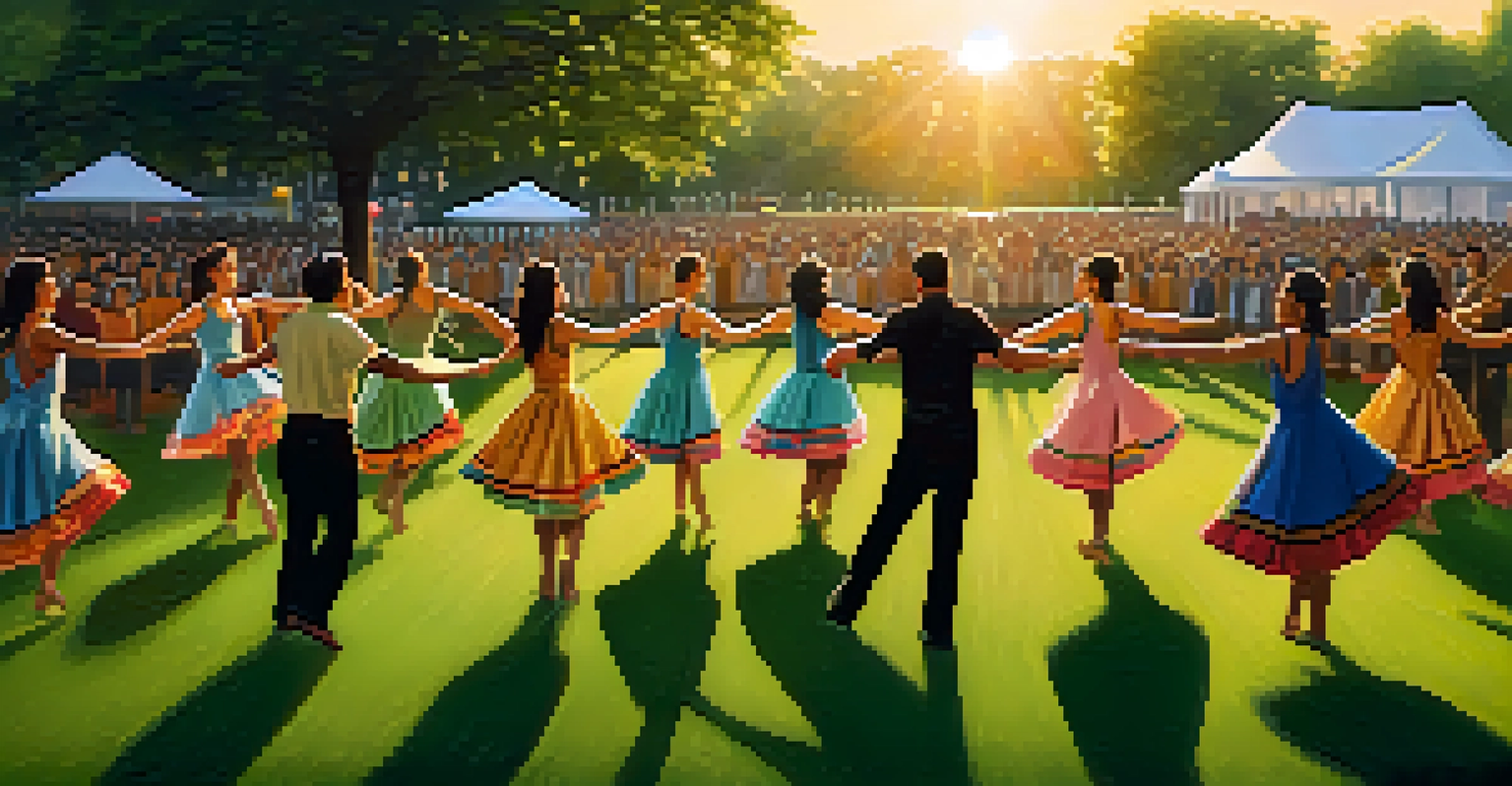The Future of Dance: Emerging Styles and Global Trends

What Defines Emerging Dance Styles Today?
Emerging dance styles are often characterized by their innovative approaches and fusion of genres. Unlike traditional forms that strictly adhere to established techniques, these styles are fluid, reflecting cultural changes and societal influences. Think of them as the 'new kids on the block' in the dance world, bringing fresh energy and creativity.
Dance is the hidden language of the soul.
For example, styles like hip-hop and contemporary dance have evolved significantly over the years, incorporating elements from various global dance forms. This blending not only makes dance more accessible but also encourages collaboration among dancers from different backgrounds. As a result, we see a vibrant tapestry of movement that resonates with diverse audiences.
Related Resource
Moreover, the digital age plays a crucial role in propelling these emerging styles into the spotlight. Social media platforms and dance challenges have created a space where new trends can gain traction overnight, making it easier for dancers to showcase their unique styles and connect with others worldwide.
The Influence of Technology on Dance
Technology is transforming the way we create, perform, and experience dance. From motion capture technology to virtual reality, the possibilities seem endless. Imagine stepping into a virtual space where you can dance alongside your favorite performers or even create choreographies using augmented reality tools.

Moreover, social media has become a powerful platform for dancers to share their work and reach global audiences. Viral dance challenges on TikTok and Instagram can catapult unknown dancers to fame, highlighting the potential of technology to democratize the dance world. This shift not only broadens the reach of dance but also encourages more diverse expressions.
Emerging Styles Reflect Cultural Fusion
Emerging dance styles are characterized by their innovative approaches and the blending of various cultural influences.
However, while technology offers exciting opportunities, it also presents challenges. The balance between digital engagement and live performance is a topic of ongoing discussion. How can dancers maintain the authenticity of their art while embracing the digital revolution? This question remains central as we navigate the future of dance.
Global Influences Shaping Dance Styles
Dance has always been a reflection of cultural exchange, and today, global influences are more pronounced than ever. Styles like Afrobeat and Bollywood dance are gaining traction in Western contexts, demonstrating the beauty of cross-cultural collaboration. This trend showcases how dance can transcend borders, uniting people through movement.
Dance is a way to find yourself and lose yourself at the same time.
In addition, international dance competitions and festivals serve as melting pots for different styles and traditions. Dancers from all corners of the globe come together, sharing their unique heritages while learning from each other. This exchange not only enriches individual dancers but also contributes to the evolution of dance as a whole.
Related Resource
As globalization continues to shape our world, we can expect to see even more diverse influences in the dance community. The blending of traditional and contemporary forms will likely lead to the emergence of entirely new styles that reflect our interconnectedness.
The Rise of Inclusive Dance Practices
Inclusivity in dance is more than just a trend; it's a movement aimed at making dance accessible to everyone, regardless of ability, background, or age. Community dance programs and workshops are popping up around the world, encouraging participation from diverse groups. This shift is vital for fostering a sense of belonging and community through movement.
For instance, dance initiatives that focus on adaptive dance allow individuals with disabilities to express themselves creatively. These programs not only provide an avenue for artistic expression but also challenge societal perceptions about who can be a dancer. By embracing inclusivity, we open the doors to a wider range of stories and experiences in the dance world.
Technology Transforms Dance Experience
The impact of technology, such as social media and virtual reality, is reshaping how dancers create, perform, and share their art.
As more dancers and choreographers prioritize inclusivity, we can anticipate a richer, more varied landscape of dance. This evolution will not only enhance the artistry of dance but also promote a more profound understanding of its role in society.
The Importance of Cultural Preservation in Dance
While embracing new styles and trends, it’s crucial to recognize the importance of cultural preservation in dance. Many traditional dance forms are at risk of fading away in a fast-paced, ever-evolving landscape. Preserving these styles ensures that future generations can appreciate their cultural significance and history.
Organizations dedicated to preserving traditional dance forms often host workshops, performances, and educational programs to share this knowledge with younger generations. For example, folk dances from various cultures are being taught in schools, allowing children to connect with their heritage. This not only fosters pride but also instills a sense of responsibility to carry these traditions forward.
Related Resource
As we celebrate innovation in dance, it’s essential to balance it with respect for the roots of the art form. By valuing both emerging styles and traditional practices, we can create a more inclusive and comprehensive dance community.
Dance as a Form of Social Commentary
Dance has long been a medium for social commentary, allowing artists to express their views on societal issues. Emerging styles often tackle themes like identity, politics, and social justice, making dance a powerful tool for change. For example, many contemporary choreographers use their work to highlight critical issues such as climate change or racial equality.
Through movement, dancers can convey emotions and narratives that resonate with audiences on a deep level. This ability to connect through dance encourages viewers to reflect on their own experiences and perspectives. It’s a reminder that dance is not just an art form but also a vehicle for dialogue and understanding.
Inclusivity Enhances Dance Community
The rise of inclusive dance practices aims to make dance accessible to everyone, enriching the community with diverse stories and experiences.
As we look to the future, we can expect more dancers to use their platforms to address pressing global issues. This trend will not only enrich the artistic landscape but also inspire audiences to engage with the world around them.
The Role of Education in Shaping Future Dance Styles
Education is a cornerstone of dance development, influencing the styles and trends that emerge over time. Dance schools and programs play a pivotal role in teaching both traditional and contemporary forms, equipping dancers with the skills they need to innovate. The curriculum often reflects current trends, ensuring that students are well-versed in the latest styles.
Moreover, mentorship programs provide aspiring dancers with the guidance and support they need to navigate their careers. Experienced professionals often share their knowledge and expertise, shaping the next generation of dancers. This passing down of knowledge creates a cycle of creativity and innovation that propels the art form forward.

As dance education continues to evolve, we can anticipate new styles and techniques that emerge from the collaboration between students and teachers. This dynamic relationship will undoubtedly shape the future of dance in exciting ways.